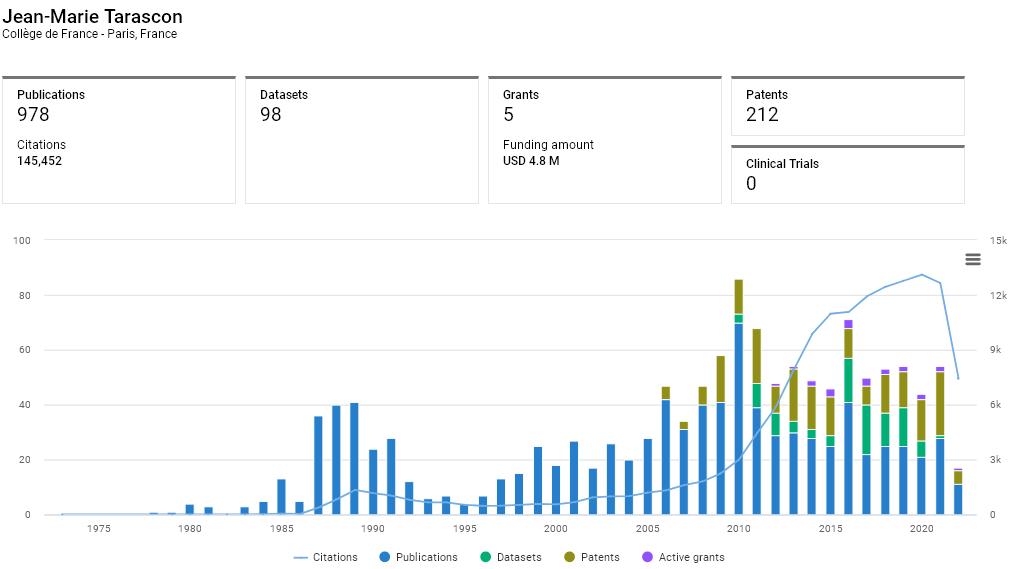博文
化学家让-马利·塔拉斯孔荣获2022 CNRS 金奖
 精选
精选
||
化学家让-马利·塔拉斯孔荣获2022 CNRS 金奖
诸平

© Frédérique PLAS / CSE / CNRS Photothèque
据法国国家科研中心(Centre national de la recherche scientifique简称CNRS)网站2022年7月7日报道,化学奖让-马利·塔拉斯孔(Jean-Marie Tarascon)荣获2022年CNRS金奖(CNRS Gold Medal)——The chemist Jean-Marie Tarascon awarded the 2022 CNRS Gold Medal
CNRS金奖创建于1954年,是法国最负盛名的科学奖项之一。今年,化学家让-马利·塔拉斯孔因其在理解和发现新的锂反应性概念、合成新的电池电极材料和电解质以及开发新的电池化学物质方面的开创性研究而获得表彰。让-马利·塔拉斯孔在CNRS相关实验室工作超过25 年,如今担任法兰西学院( Collège de France)教授。2022年12月14日,将在巴黎举行的颁奖典礼上,CNRS金牌以及CNRS基金会提供的5万欧元捐款将授予他。
让-马利·塔拉斯孔于 1953 年出生于法国马尔芒德 (Marmande, Lot-et-Garonne),是固态化学和电化学方面的专家。自 2004 年以来,他一直是法国科学院院士,并于2014年加入法兰西学院。在他的整个职业生涯中,他同时进行基础研究并寻求该研究的应用,从未在科学卓越方面做出让步. 他领导着固态化学和能源实验室(Solid-State Chemistry and Energy Laboratory),该实验室是由法国国家科研中心(Centre national de la recherche scientifique简称CNRS)、法兰西学院以及索邦大学(Sorbonne Université)联合共建的;还有电化学储能研究网络 (Research Network on Electrochemical Energy Storage简称RS2E )。RS2E由CNRS于2011年在法国高等教育和研究部(French Ministry of Higher Education and Research)的支持下创建,汇集了来自 CNRS 及其合作伙伴的 17 个实验室,此外还有由 CEA、INERIS 和 IFPEN 领导的技术转移平台,作为技术与集成研究中心(Technology and Integration Research Centre)。自从让-马利·塔拉斯孔在美国的早期职业生涯以来,他一直在学术界和工业界的交汇处游走于想法和原型之间。
对于CNRS主席兼首席执行官安托万·佩蒂特(Antoine Petit)来说,“ 让-马利·塔拉斯孔的研究对于当前和未来的科学挑战和环境问题至关重要,即在坚持生态概念、安全和环保原则的同时储存能源。CNRS想通过授予他2022年金质奖章来表彰他卓越的学术生涯。他是国际知名的电池材料相关基础研究的领导者之一,特别是通过他对锂离子电池的开创性研究而脱颖而出。 ”
在获得波尔多大学(Université de Bordeaux)化学学院材料物理化学博士学位后,让-马利·塔拉斯孔于1980年前往美国,在美国康奈尔大学(Cornell University)完成博士后研究,然后加入了美国新泽西的贝尔实验室(Bell laboratories in New Jersey)。1983年,他被其专注于电信业务的子公司贝尔通讯研究所(Bellcore)聘用,并在竞争激烈的高温超导体领域工作。1989年,美国加利福尼亚州的洛马普列塔地震(Loma Prieta earthquake in California)将他带回了电池领域,因为铅基电池的自主性在紧急情况下被证明是不够的。他成为了一个专注于电化学储能团队的负责人。探索刚起步的锂电池,他和他的团队使用完全采用塑料封装的新系统开发了第一款超扁平锂电池,该系统既灵活又安全。这项获得高度专利的技术已授权给20家电池制造商,如今已应用于一些电动汽车。
1995年回到法国后,让-马利·塔拉斯孔领导了法国亚眠的反应性和固态化学实验室(Laboratory of Reactivity and Solid-State Chemistry in Amiens),作为皮卡第·儒勒·凡尔纳大学(Université de Picardie Jules Verne)的教授,他致力于后锂离子电池(post Li-ion batteries)的先进技术。2003年,他创建了ALISTORE-ERI 欧洲卓越网络(ALISTORE-ERI European network of excellence),并于2011年创建了CNRS研究网络RS2E,这是法国第一个将工业和学术界聚集在一起的能源网络。在仍然指导RS2E的让-马利·塔拉斯孔的领导下,它开发了钠离子电池(Sodium-ion battery)。虽然与锂离子电池相比,这种电池的性能略低,但它对可再生能源的固定存储非常感兴趣,这样做成本较低,并使用地球上最丰富的元素之一——钠(Na, sodium)。这些新电池的开发促成了2017年初创公司提亚玛特(TIAMAT)的成立,并将其推向市场。让-马利·塔拉斯孔的其他值得注意的奖项包括2017年CNRS创新奖章(2017 CNRS Innovation Medal)和 2020年巴尔赞奖(2020 Balzan Prize)。
让-马利·塔拉斯孔是一位多产的研究人员和优秀的教师,他将部分时间投入到各个层次的教学中,尤其是在研究生阶段。他参与科学文化的传播,并在多所小学发表演讲,传达他对研究的热情,并激发年轻一代对科学的早期兴趣。他还参加了各种国际研讨会和能源决策委员会,并起草了有关同一主题的前瞻性文章。他不断探索新的科学视野,现在致力于开发带有集成传感器的智能和自我修复电池,以监测材料的缺陷以及持续的磨损。
在 CNRS 图像平台上查找获胜者的照片(Find photos of the winner on the CNRS Images platform)。
在 CNRS 新闻中发现他的肖像(Discover his portrait in CNRS News)。
让·马力·塔拉斯孔目前是法兰西公学院(College-de-France)教授,法国科学院院士,英国皇家化学学会会员。目前他已发表研究成果900余篇,拥有200余项专利(见下面截图所示)。他是发明聚合物锂离子电池的鼻祖,他开创了将软包装应用于锂电池的先例,从而使得聚合物锂离子电成为目前的主流电池产品。20世纪90年代初期,让·马力·塔拉斯孔带领的研究小组研制了用于高电位正极材料的电解液,从而创造了以铝箔包装锰酸锂锂离子电池为特征的BELLCORE技术。他创造性的引入EC作为电解液的溶剂,使得石墨材料真正能用作锂离子电池负极。他率先成功开发出了PEO基固态聚合物电解质,这也是当前全固态电池应用最为广泛的电解质。在新型正极材料开发方面让·马力·塔拉斯孔也是硕果累累。他率先合成出了具有尖晶石结构的LiMn2O4正极材料。通过对合成条件中氧气氛的精确调控,首次开发出了富锂富氧锰酸锂正极材料,可以大幅提升电池材料的比容量。
上述介绍,仅供参考。欲了解更多信息,敬请注意浏览原文或者相关报道。
让·马力·塔拉斯孔的研究成果(Dimensions)
让·马力·塔拉斯孔的高引(≥500次)成果
Title, Author(s), Bibliographic reference | Citations |
Electrical Energy Storage for the Grid: A Battery of Choices Bruce Dunn, Haresh Kamath, Jean-Marie Tarascon 2011, Science - Article The increasing interest in energy storage for the grid can be attributed to multiple factors, including the capital costs of managing peak demands, the investments needed for grid reliability, and the...more | |
Nanostructured materials for advanced energy conversion and storage devices Antonino Salvatore Aricò, Peter Bruce, Bruno Scrosati, Jean-Marie Tarascon, Walter van Schalkwijk 2005, Nature Materials - Article New materials hold the key to fundamental advances in energy conversion and storage, both of which are vital in order to meet the challenge of global warming and the finite nature of fossil fuels. Nan...more |
|
Li–O2 and Li–S batteries with high energy storage Peter G. Bruce, Stefan A. Freunberger, Laurence J. Hardwick, Jean-Marie Tarascon 2011, Nature Materials - Article The amount of energy that can be stored in Li-ion batteries is insufficient for the long-term needs of society, for example, for use in extended-range electric vehicles. Here, the energy-storage capab...more |
|
Nanomaterials for Rechargeable Lithium Batteries Peter G. Bruce, Bruno Scrosati, Jean‐Marie Tarascon 2008, Angewandte Chemie International Edition - Article Energy storage is more important today than at any time in human history. Future generations of rechargeable lithium batteries are required to power portable electronic devices (cellphones, laptop com...more |
|
Towards greener and more sustainable batteries for electrical energy storage D. Larcher, J-M. Tarascon 2014, Nature Chemistry - Article Energy storage using batteries offers a solution to the intermittent nature of energy production from renewable sources; however, such technology must be sustainable. This Review discusses battery dev...more |
|
Comparison of Modeling Predictions with Experimental Data from Plastic Lithium Ion Cells Marc Doyle, John Newman, Antoni S. Gozdz, Caroline N. Schmutz, Jean‐Marie Tarascon 1996, Journal of The Electrochemical Society - Article Modeling results for a lithium‐ion battery based on the couple are presented and compared to experimental data. Good agreement between simulation and experiment exists for several different experiment...more |
|
Jean-Marie Tarascon 2010, Nature Chemistry - Article Jean-Marie Tarascon ponders on the value of lithium, an element known for about 200 years, whose importance is now fast increasing in view of the promises it holds for energy storage and electric cars...more |
|
Lee Johnson, Chunmei Li, Zheng Liu, Yuhui Chen, Stefan A. Freunberger, Praveen C. Ashok, Bavishna B. Praveen, Kishan Dholakia, Jean-Marie Tarascon, Peter G. Bruce 2014, Nature Chemistry - Article When lithium–oxygen batteries discharge, O2 is reduced at the cathode to form solid Li2O2. Understanding the fundamental mechanism of O2 reduction in aprotic solvents is therefore essential to realizi...more |
|
Na2Ti3O7: Lowest Voltage Ever Reported Oxide Insertion Electrode for Sodium Ion Batteries Premkumar Senguttuvan, Gwenaëlle Rousse, Vincent Seznec, Jean-Marie Tarascon, M.Rosa Palacín 2011, Chemistry of Materials - Article Na2Ti3O7 is found to reversibly uptake 2 Na ions per formula unit (200 mA h/g) at an average potential of 0.3 V and is hence a very promising negative electrode material for building sodium ion batter...more |
|
Fundamental understanding and practical challenges of anionic redox activity in Li-ion batteries Gaurav Assat, Jean-Marie Tarascon 2018, Nature Energy - Article Our increasing dependence on lithium-ion batteries for energy storage calls for continual improvements in the performance of their positive electrodes, which have so far relied solely on cationic redo...more |
|
In search of an optimized electrolyte for Na-ion batteries Alexandre Ponrouch, Elena Marchante, Matthieu Courty, Jean-Marie Tarascon, M. Rosa Palacín 2012, Energy & Environmental Science - Article Electrolytes are essential for the proper functioning of any battery technology and the emerging Na-ion technology is no exception. Hence, a major focus on battery research is to identify the most app...more |
|
Dominique Larcher, Shane Beattie, Mathieu Morcrette, Kristina Edström, Jean-Claude Jumas, Jean-Marie Tarascon 2007, Journal of Materials Chemistry - Article In the race for better Li-ion batteries, research on anode materials is very intensive as there is a strong desire to find alternatives to carbonaceous negative electrodes. A large part of these studi...more |
|
Room-temperature single-phase Li insertion/extraction in nanoscale LixFePO4 Pierre Gibot, Montse Casas-Cabanas, Lydia Laffont, Stephane Levasseur, Philippe Carlach, Stéphane Hamelet, Jean-Marie Tarascon, Christian Masquelier 2008, Nature Materials - Article Classical electrodes for Li-ion technology operate by either single-phase or two-phase Li insertion/de-insertion processes, with single-phase mechanisms presenting some intrinsic advantages with respe...more |
|
Real-Time NMR Investigations of Structural Changes in Silicon Electrodes for Lithium-Ion Batteries Baris Key, Rangeet Bhattacharyya, Mathieu Morcrette, Vincent Seznéc, Jean-Marie Tarascon, Clare P. Grey 2009, Journal of the American Chemical Society - Article Lithium-ion batteries (LIBs) containing silicon negative electrodes have been the subject of much recent investigation because of the extremely large gravimetric and volumetric capacity of silicon. Th...more |
|
Gérard Férey, Franck Millange, Mathieu Morcrette, Christian Serre, Marie‐Liesse Doublet, Jean‐Marc Grenèche, Jean‐Marie Tarascon 2007, Angewandte Chemie International Edition - Article There's more to LiFe: When used as an electrode in a lithium half cell, the metal–organic framework [LixFeIIxFeIII1−x(OH)0.8F0.2L] (L=O2CC6H4CO2) shows a reversible redox process around 3.0 V ver...more |
|
Visualization of O-O peroxo-like dimers in high-capacity layered oxides for Li-ion batteries Eric McCalla, Artem M Abakumov, Matthieu Saubanère, Dominique Foix, Erik J Berg, Gwenaelle Rousse, Marie-Liesse Doublet, Danielle Gonbeau, Petr Novák, Gustaaf Van Tendeloo, Robert Dominko, Jean-Marie Tarascon 2015, Science - Article Lithium-ion (Li-ion) batteries that rely on cationic redox reactions are the primary energy source for portable electronics. One pathway toward greater energy density is through the use of Li-rich lay...more |
|
From Biomass to a Renewable LiXC6O6 Organic Electrode for Sustainable Li‐Ion Batteries Haiyan Chen, Michel Armand, Gilles Demailly, Franck Dolhem, Philippe Poizot, Jean‐Marie Tarascon 2008, ChemSusChem - Article Li-ion batteries presently operate on inorganic insertion compounds. The abundance and materials life-cycle costs of such batteries may present issues in the long term with foreseeable large-scale app...more |
|
Cathode Composites for Li–S Batteries via the Use of Oxygenated Porous Architectures Rezan Demir-Cakan, Mathieu Morcrette, Farid Nouar, Carine Davoisne, Thomas Devic, Danielle Gonbeau, Robert Dominko, Christian Serre, Gérard Férey, Jean-Marie Tarascon 2011, Journal of the American Chemical Society - Article Li-S rechargeable batteries are attractive for electric transportation because of their low cost, environmentally friendliness, and superior energy density. However, the Li-S system has yet to conquer...more |
|
https://blog.sciencenet.cn/blog-212210-1346959.html
上一篇:科学家发明了“量子长笛”,可以让光子一起运动
下一篇:一种常见的药物可“开启”致癌基因?
